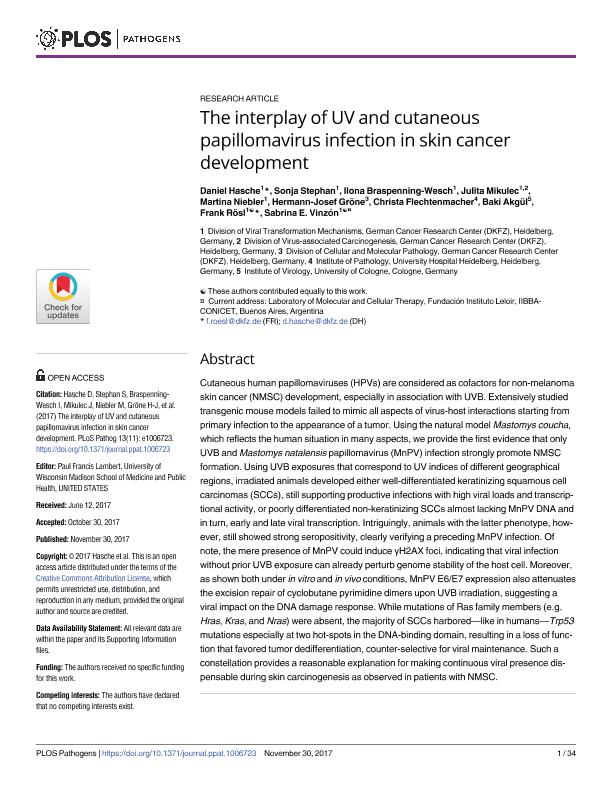Mostrar el registro sencillo del ítem
dc.contributor.author
Hasche, Daniel
dc.contributor.author
Stephan, Sonja
dc.contributor.author
Braspenning Wesch, Ilona
dc.contributor.author
Mikulec, Julita
dc.contributor.author
Niebler, Martina
dc.contributor.author
Gröne, Hermann Josef
dc.contributor.author
Flechtenmacher, Christa
dc.contributor.author
Akgül, Baki
dc.contributor.author
Rösl, Frank
dc.contributor.author
Vinzon, Sabrina Eugenia

dc.date.available
2018-02-28T18:22:13Z
dc.date.issued
2017-11
dc.identifier.citation
Hasche, Daniel; Stephan, Sonja; Braspenning Wesch, Ilona; Mikulec, Julita; Niebler, Martina; et al.; The interplay of UV and cutaneous papillomavirus infection in skin cancer development; Public Library Of Science; PLoS pathogens; 13; 11; 11-2017; 1-34; e1006723
dc.identifier.issn
1553-7374
dc.identifier.uri
http://hdl.handle.net/11336/37405
dc.description.abstract
Cutaneous human papillomaviruses (HPVs) are considered as cofactors for non-melanoma skin cancer (NMSC) development, especially in association with UVB. Extensively studied transgenic mouse models failed to mimic all aspects of virus-host interactions starting from primary infection to the appearance of a tumor. Using the natural model Mastomys coucha, which reflects the human situation in many aspects, we provide the first evidence that only UVB and Mastomys natalensis papillomavirus (MnPV) infection strongly promote NMSC formation. Using UVB exposures that correspond to UV indices of different geographical regions, irradiated animals developed either well-differentiated keratinizing squamous cell carcinomas (SCCs), still supporting productive infections with high viral loads and transcriptional activity, or poorly differentiated non-keratinizing SCCs almost lacking MnPV DNA and in turn, early and late viral transcription. Intriguingly, animals with the latter phenotype, however, still showed strong seropositivity, clearly verifying a preceding MnPV infection. Of note, the mere presence of MnPV could induce γH2AX foci, indicating that viral infection without prior UVB exposure can already perturb genome stability of the host cell. Moreover, as shown both under in vitro and in vivo conditions, MnPV E6/E7 expression also attenuates the excision repair of cyclobutane pyrimidine dimers upon UVB irradiation, suggesting a viral impact on the DNA damage response. While mutations of Ras family members (e.g. Hras, Kras, and Nras) were absent, the majority of SCCs harbored-like in humans-Trp53 mutations especially at two hot-spots in the DNA-binding domain, resulting in a loss of function that favored tumor dedifferentiation, counter-selective for viral maintenance. Such a constellation provides a reasonable explanation for making continuous viral presence dispensable during skin carcinogenesis as observed in patients with NMSC.
dc.format
application/pdf
dc.language.iso
eng
dc.publisher
Public Library Of Science
dc.rights
info:eu-repo/semantics/openAccess
dc.rights.uri
https://creativecommons.org/licenses/by-nc-sa/2.5/ar/
dc.subject
Papillomavirus
dc.subject
Mastomys Coucha
dc.subject
Non-Melanoma Skin Cancer
dc.subject
Uv
dc.subject
Dedifferentiation
dc.subject.classification
Otras Ciencias Biológicas

dc.subject.classification
Ciencias Biológicas

dc.subject.classification
CIENCIAS NATURALES Y EXACTAS

dc.title
The interplay of UV and cutaneous papillomavirus infection in skin cancer development
dc.type
info:eu-repo/semantics/article
dc.type
info:ar-repo/semantics/artículo
dc.type
info:eu-repo/semantics/publishedVersion
dc.date.updated
2018-01-12T19:28:18Z
dc.journal.volume
13
dc.journal.number
11
dc.journal.pagination
1-34; e1006723
dc.journal.pais
Estados Unidos

dc.journal.ciudad
Nueva York
dc.description.fil
Fil: Hasche, Daniel. German Cancer Research Center; Alemania
dc.description.fil
Fil: Stephan, Sonja. German Cancer Research Center; Alemania
dc.description.fil
Fil: Braspenning Wesch, Ilona. German Cancer Research Center; Alemania
dc.description.fil
Fil: Mikulec, Julita. German Cancer Research Center; Alemania
dc.description.fil
Fil: Niebler, Martina. German Cancer Research Center; Alemania
dc.description.fil
Fil: Gröne, Hermann Josef. German Cancer Research Center; Alemania
dc.description.fil
Fil: Flechtenmacher, Christa. University Hospital Heidelberg;
dc.description.fil
Fil: Akgül, Baki. University of Cologne; Alemania
dc.description.fil
Fil: Rösl, Frank. German Cancer Research Center; Alemania
dc.description.fil
Fil: Vinzon, Sabrina Eugenia. German Cancer Research Center; Alemania. Consejo Nacional de Investigaciones Científicas y Técnicas. Oficina de Coordinación Administrativa Parque Centenario. Instituto de Investigaciones Bioquímicas de Buenos Aires. Fundación Instituto Leloir. Instituto de Investigaciones Bioquímicas de Buenos Aires; Argentina
dc.journal.title
PLoS pathogens
dc.relation.alternativeid
info:eu-repo/semantics/altIdentifier/url/http://journals.plos.org/plospathogens/article?id=10.1371/journal.ppat.1006723
dc.relation.alternativeid
info:eu-repo/semantics/altIdentifier/doi/http://dx.doi.org/10.1371/journal.ppat.1006723
Archivos asociados
